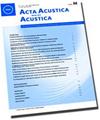建筑基础隔震原位性能评价的间接方法
Q1 Arts and Humanities
引用次数: 1
摘要
缓解建筑物中铁路振动的措施包括在建筑物基础和上层结构之间插入弹性支架或弹簧。本文旨在对此类建筑基础隔震的现场性能进行现场评价。定义并使用了两个性能指标,均表示为插入增益:基于传输到建筑物上层结构的功率的功率流插入增益(PFIG)和基于建筑物楼层速度的建筑物插入增益指标(BIGI)。本文表明,这两个指标都可以用来评估基础隔离建筑的现场性能:PFIG可以间接地从隔离器传播率的局部测量和接触建筑结构的移动强度的一些知识中获得,BIGI可以间接地从处理过的建筑传播率(按照ISO/TS 14837-31的定义)的测量中获得,以及一些类似但未经处理的建筑的传播率的知识。通过一个易于计算且具有足够真实感的二维地基结构数值模型,成功地验证了上述方法。文章最后讨论了在实际建筑现场获得这些性能的可行性。本文章由计算机程序翻译,如有差异,请以英文原文为准。
Indirect Methods for Evaluating the In-Situ Performance of Building Base Isolation
Mitigation measures against railway vibration in buildings include elastomeric mounts or springs inserted between building foundations and upper-structures. This paper aims at evaluating on site the field performance of such building base isolation. Two performance indicators are defined
and used, both expressed as insertion gain: a Power Flow insertion Gain (PFIG) based on the power transmitted to the building upper-structure, and a Building Insertion Gain Indicator (BIGI) based on the building floor velocities. The paper shows that both indicators can be used to evaluate
the field performance of base-isolated buildings: the PFIG can be indirectly obtained from local measurements of the isolator transmissibility and some knowledge of the mobility magnitudes of the building structures in contact and the BIGI indirectly obtained from measurements of the treated
building transmissibility (as defined in ISO/TS 14837-31) and some knowledge of the transmissibility of similar but untreated buildings. The methods are successfully validated using a numerical model of a 2D ground-building configuration easy to calculate and assumed realistic enough. The
paper ends with a discussion on the practicality of obtaining these performances on- site in real buildings.
求助全文
通过发布文献求助,成功后即可免费获取论文全文。
去求助
来源期刊
CiteScore
2.60
自引率
0.00%
发文量
0
审稿时长
6.8 months
期刊介绍:
Cessation. Acta Acustica united with Acustica (Acta Acust united Ac), was published together with the European Acoustics Association (EAA). It was an international, peer-reviewed journal on acoustics. It published original articles on all subjects in the field of acoustics, such as
• General Linear Acoustics, • Nonlinear Acoustics, Macrosonics, • Aeroacoustics, • Atmospheric Sound, • Underwater Sound, • Ultrasonics, • Physical Acoustics, • Structural Acoustics, • Noise Control, • Active Control, • Environmental Noise, • Building Acoustics, • Room Acoustics, • Acoustic Materials and Metamaterials, • Audio Signal Processing and Transducers, • Computational and Numerical Acoustics, • Hearing, Audiology and Psychoacoustics, • Speech,
• Musical Acoustics, • Virtual Acoustics, • Auditory Quality of Systems, • Animal Bioacoustics, • History of Acoustics.

 求助内容:
求助内容: 应助结果提醒方式:
应助结果提醒方式:


